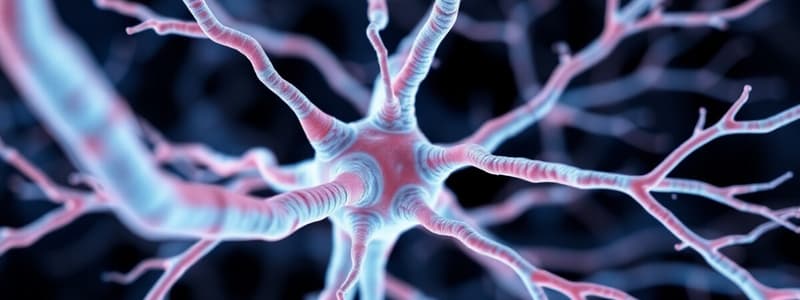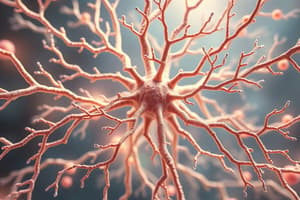Podcast
Questions and Answers
What is the primary function of neurons in the nervous system?
What is the primary function of neurons in the nervous system?
- To connect the left and right hemispheres of the brain
- To regulate involuntary functions
- To carry messages to and from different body parts (correct)
- To transmit electrical impulses between the brain and spinal cord
Which part of the neuron is primarily responsible for receiving signals from other neurons?
Which part of the neuron is primarily responsible for receiving signals from other neurons?
- Soma
- Axon
- Synapse
- Dendrites (correct)
What role does the corpus callosum serve in the brain?
What role does the corpus callosum serve in the brain?
- Connects the left and right hemispheres (correct)
- Facilitates voluntary movements
- Regulates autonomic functions
- Processes sensory information
Which nervous system division controls voluntary movements?
Which nervous system division controls voluntary movements?
Which part of the brain is primarily responsible for autonomic functions such as breathing and heart rate?
Which part of the brain is primarily responsible for autonomic functions such as breathing and heart rate?
What is the function of a synapse?
What is the function of a synapse?
Which system regulates involuntary functions like digestion and body temperature?
Which system regulates involuntary functions like digestion and body temperature?
What are the three types of neurons in the nervous system?
What are the three types of neurons in the nervous system?
Which part of the brain is primarily responsible for regulating body temperature?
Which part of the brain is primarily responsible for regulating body temperature?
What is the main function of the central nervous system?
What is the main function of the central nervous system?
The knee jerk test is used to assess which part of the nervous system?
The knee jerk test is used to assess which part of the nervous system?
Which component of the peripheral nervous system controls voluntary movements?
Which component of the peripheral nervous system controls voluntary movements?
Which of the following functions is regulated by the autonomic nervous system?
Which of the following functions is regulated by the autonomic nervous system?
Which brain hemisphere is associated with logical and analytical thinking?
Which brain hemisphere is associated with logical and analytical thinking?
Which structure in the brain is responsible for relaying sensory and motor impulses?
Which structure in the brain is responsible for relaying sensory and motor impulses?
Flashcards
Nerve
Nerve
A bundle of long, thin fibers (called axons) that transmit electrical impulses between the brain, spinal cord, and other parts of the body
Cerebral Cortex
Cerebral Cortex
The outermost layer of the brain. Plays a key role in many of the brain's most complex functions, including sensory perception, voluntary movement, reasoning, memory, and language.
Synapse
Synapse
A junction between two neurons, consisting of a small gap where information is transmitted through neurotransmitters.
Corpus Callosum
Corpus Callosum
Signup and view all the flashcards
Nerve Impulse
Nerve Impulse
Signup and view all the flashcards
Dendrites
Dendrites
Signup and view all the flashcards
Neuron
Neuron
Signup and view all the flashcards
Medulla Oblongata
Medulla Oblongata
Signup and view all the flashcards
Sensory Neurons
Sensory Neurons
Signup and view all the flashcards
Interneurons
Interneurons
Signup and view all the flashcards
Motor Neurons
Motor Neurons
Signup and view all the flashcards
Central Nervous System
Central Nervous System
Signup and view all the flashcards
Cerebellum
Cerebellum
Signup and view all the flashcards
Thalamus
Thalamus
Signup and view all the flashcards
Hypothalamus
Hypothalamus
Signup and view all the flashcards
Knee Jerk Test
Knee Jerk Test
Signup and view all the flashcards
Study Notes
Nervous System Overview
- The nervous system is a complex network of cells and organs coordinating bodily activities.
- It responds to internal and external stimuli, regulating functions, and enabling communication between body parts.
- This intricate system also controls movement, thoughts, emotions, and behaviors.
Neuron Structure and Function
- Neurons are the basic functional units.
- They carry messages to and from various body parts.
- Dendrites, branched structures, receive signals from other neurons.
- Nerve impulses are electrical signals travelling along axons.
- Synapses are junctions between neurons, enabling communication via neurotransmitters.
Nervous System Divisions
- The nervous system is divided into Central and Peripheral systems.
- The Central Nervous System (CNS) consists of the brain and spinal cord.
- It processes information, controls movement, and manages higher cognitive functions.
- The Peripheral Nervous System (PNS) includes nerves outside the CNS.
- Its somatic division controls voluntary movements (walking, picking things up).
- The autonomic division regulates involuntary functions (e.g., breathing, heart rate).
Brain Structures
- Cerebral cortex: The outermost brain layer, involved in complex functions (sensory perception, movement, language, memory).
- Corpus Callosum: Connects the brain's hemispheres, enabling information sharing.
- Medulla oblongata: Part of the brainstem, controls vital autonomic functions (breathing, heart rate, blood pressure).
- Cerebellum: Crucial for movement and coordination.
- Thalamus: Relays sensory and motor impulses to the cerebral cortex.
- Hypothalamus: Regulates body temperature and controls emotions and sensations.
Knee-Jerk Reflex
- The knee-jerk test (patellar reflex) assesses lower spinal cord function.
- It evaluates the reflex pathways.
- This test can diagnose conditions that affect the spinal cord, nerves, or muscles (e.g., nerve damage, spinal cord injury, multiple sclerosis).
Studying That Suits You
Use AI to generate personalized quizzes and flashcards to suit your learning preferences.




